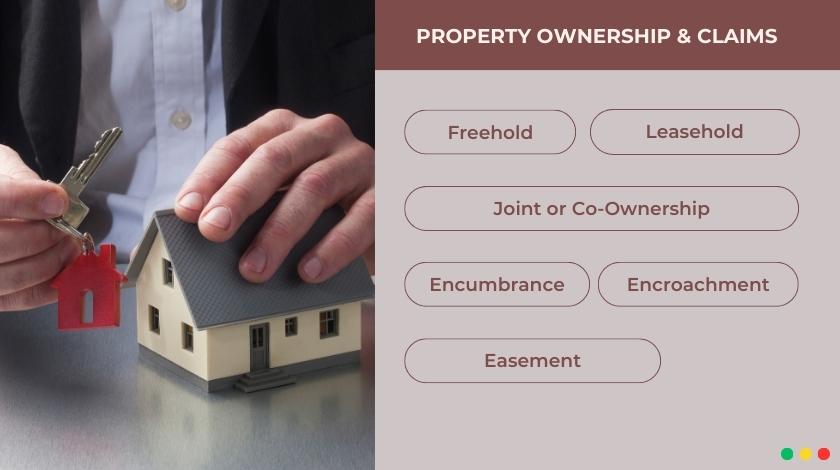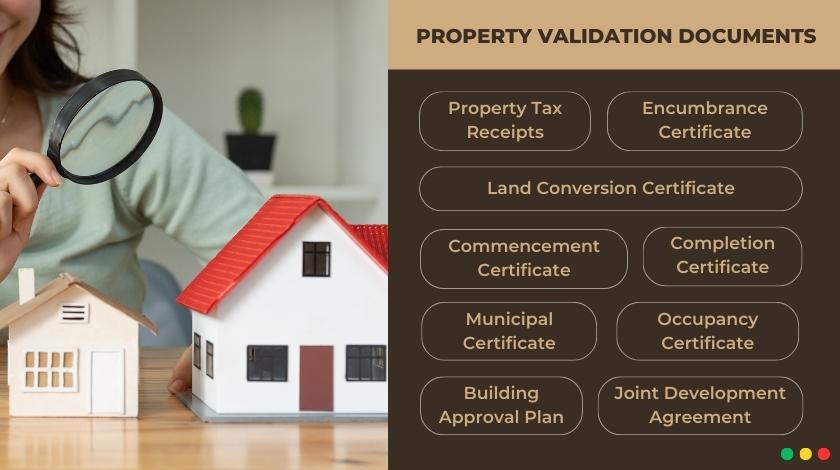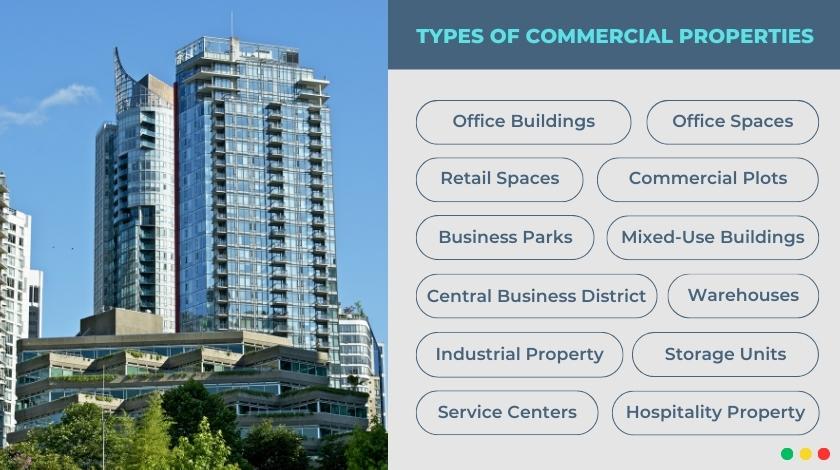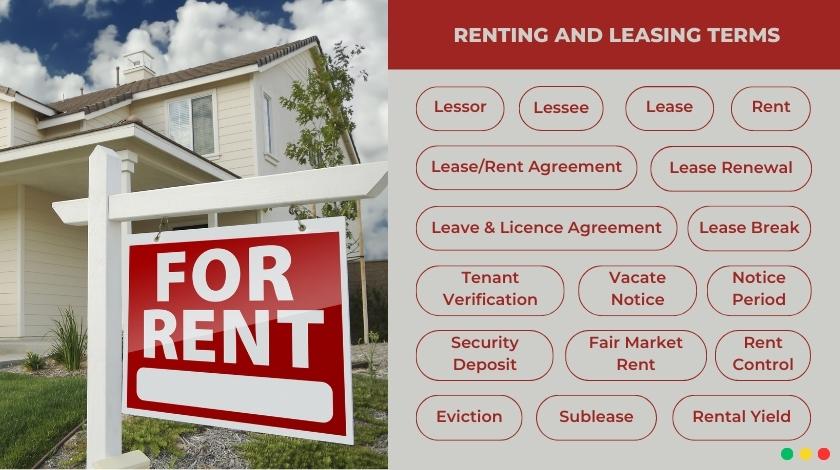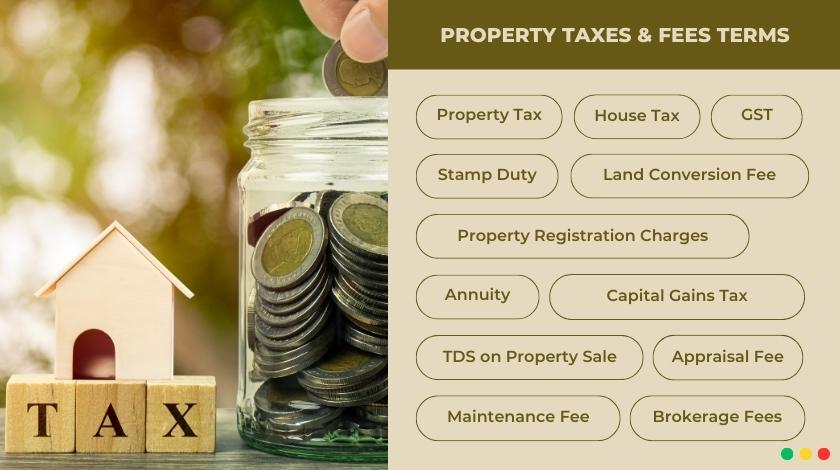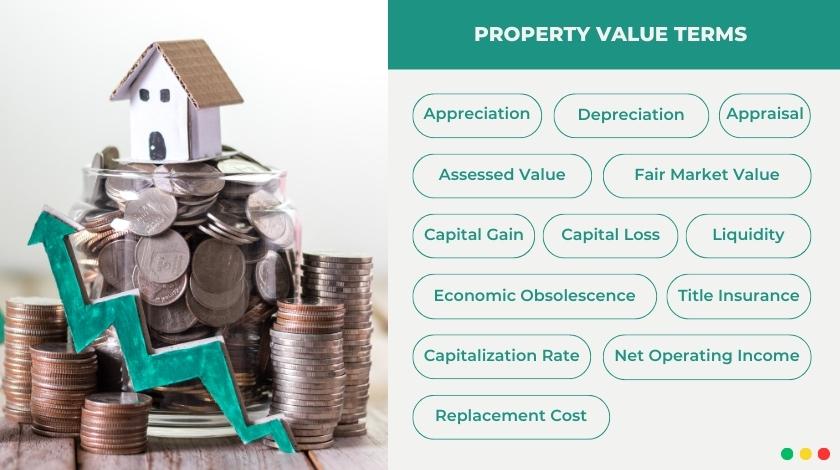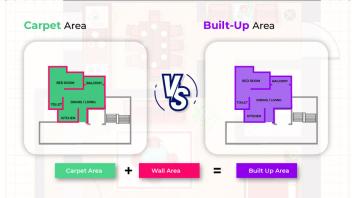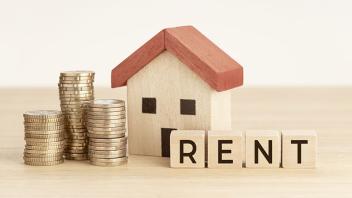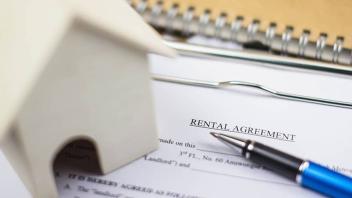150+ Real Estate Terms to Know: Ultimate Glossary of Real Estate Terminologies & Words
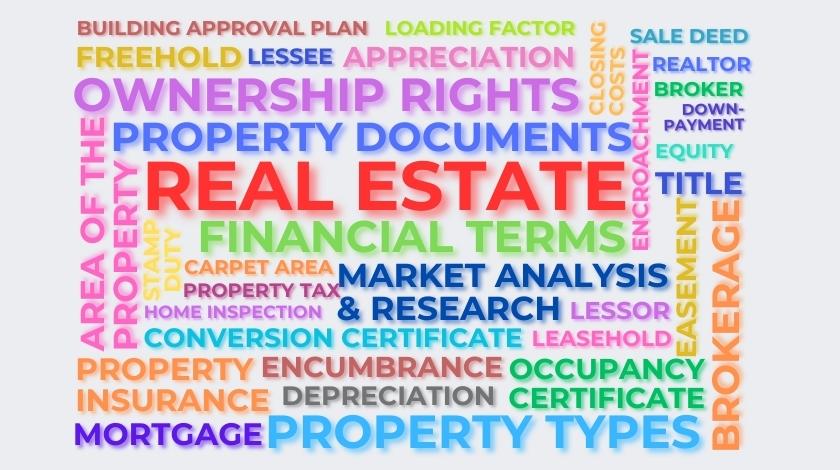
Navigating the vast realm of real estate can often be complex and confusing. The real estate terminology alone can seem like an entirely different language. Recognizing this challenge, we have crafted this comprehensive glossary of terms to break down and explain real estate terms that are frequently encountered when making real estate transactions in India.
Instead of offering a simple alphabetical list of the real estate jargon, we have innovatively categorised the most crucial real estate terms in India according to the specific areas and use-case scenario during which they may be used, for easier understanding.
Here's a glimpse of our structured approach to explaining the words related to real estate:
A. Legal Terms in Real Estate: Spanning topics from the types of property ownership to the crucial laws governing real estate in India.
B. Real Estate Words related to the Types of Real Estate Properties & Size: Dive deep into the definitions and specifications of residential and commercial properties, as well as understanding the varying sizes.
C. Real Estate Terms related to Buying, Selling, Renting, Leasing Processes: Here you will find all the real estate vocabulary related to the processes of buying, selling, renting, and leasing properties.
D. Real Estate Terminologies of Financial Terms: An essential category elucidating on property taxes, home loans, mortgage details, and the factors determining property value.
Whether you're a seasoned real estate professional, a first-time buyer, or simply curious about what the meaning of real estate truly encompasses, this structure will be particularly handy when you want to be informed about a particular segment in real estate.
Table of Contents
A1. Types of Ownership Rights & Property Claims
A2. Ownership & Transfer Documents
A3. Property Validation Documents
A4. Property Laws in Real Estate
B. Types of Real Estate Properties & Size
D. Financial Terms in Real Estate
A. Legal Terms in Real Estate
A1. Types of Ownership Rights & Property Claims
1. Freehold
Freehold property can be defined as any property that is "free from hold" of any person/entity other than the owner, also known as the "freeholder". As a freeholder, you own the building as well as the land it’s built on, for an indefinite period of time, and can be inherited by a legal guardian. It is free from any encumbrances and can be easily transferred by registration of the sale deed.
2. Leasehold
Leasehold means you have the absolute right to occupy and use a property for a fixed period of time called the leasehold period (30, 60, 99 years), but you don’t have authority on the land the property is built on. A good example of leasehold property is the land given to project developers or builders who construct apartment/townships.
3. Co-ownership/ Joint Ownership
When there is more than one owner of a property, whereby each co-owner shares their interest in the property together, it is called a co-owned or jointly owned property.
4. Encumbrance
Encumbrance is a claim against a property by someone who is not the property owner. These are usually claimed when the property owner fails to pay the property taxes or easement charges on time. Encumbrances impacts the free use of the property and the property owner is restricted from making any renovations, sale, or transfer of the property till the dues are cleared.
5. Encroachment
Encroachment occurs when a property owner infringes on the neighbour's property rights by erecting a structure on the neighbor's land or authorising an extension onto the neighbour's land.
6. Easement
An easement is a legal right of one party to use the property of another for a specific purpose like accessing a public road or laying down utility lines/pipes. A fee must be paid to the property owner for the right of easement.
A2. Ownership and Transfer Documents
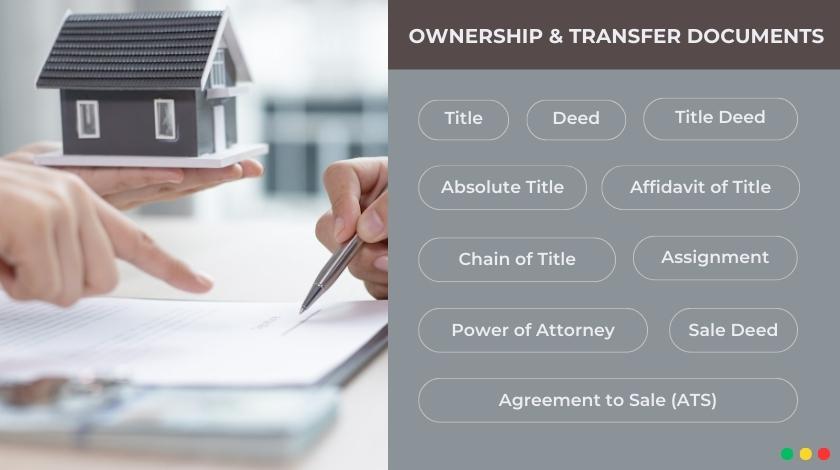
7. Title
Title is a legal right granting the ownership rights or transferring interest of a property to a person or entity through a deed.
8. Deed
A deed is a legal document that is used to transfer the rights of property in real estate transactions. The name of the seller, buyer, detailed property description, and signatures of both parties are essential to ensure the deed is legal.
9. Title Deed
A title deed is a formal, legal document explaining how a property is transferred, inherited, owned, or allotted by a government authority. It outlines the information of the amount of land owned by a person and the rights of ownership
10. Absolute Title
An absolute title (or perfect title) of a property gives the definite legal ownership and right to the owner of a property in which they can sell, rent, or lease out the property as they wish. It also denotes that the property is free from any encumbrances and is evidence that the holder of an absolute title has full ownership rights to the property and it cannot be contested or disputed by anyone else.
11. Affidavit of Title
The affidavit of title is a sworn statement provided by the seller to explicitly state the legal status of the property, including that they are the legal owner of the property, outstanding legal issues against the property, etc.
12. Chain of Title
The Chain of Title is the official record of ownership of a property and is important in tracing the historical transfers from the current owner to the original owner. The accurate title records are maintained by a centralised registry.
13. Assignment
An assignment is a legal term to indicate the transfer of rights and obligations of a property from one party to another, before the legal ownership of the property is transferred.
13a. Assignor
An assignor is a person or entity who passes on or transfers the rights and obligations of the contract assignment to a third party, called the ‘Assignee’. They are the original party of the contract assignment and they hold the authority to limit the assignee’s scope of operations to the real estate property, real estate investment, intellectual property, or anything else that the assignor wishes to “assign” to the buyer.
13b. Assignee
An assignee is a person or entity who agrees to receive the transfer of rights and obligations from the ‘assignor’ (the original party) as per the terms of the contractual assignment. An assignee is generally not the original party in the contract assignment and will need to relinquish their rights if the assignor wishes to pull back the contract.
14. Power of Attorney
Power of attorney is a legal document authorising another person (known as an agent) to take actions and decisions on behalf of the principal (the person who created the authorisation). If the property is being sold through a Power of Attorney, it is essential to verify the Power of Attorney document's validity.
15. Sale Deed
This legal document acts as proof that the property has been transferred from the seller to the buyer. It should be duly stamped and registered.
16. Agreement to Sale (ATS)
This is an agreement made between the seller and buyer that details the prices and terms of the sale of the property. An Agreement to Sale document is not the same as the Sale Deed and it acts as the foundation for the Sale Deed will be drafted.
A3. Property Validation Documents
17. Property Tax Receipts
Property tax receipts serve as proof that the annual taxes related to the property, that must be paid to the local government or municipal corporation, are up-to-date.
18. Encumbrance Certificate
The encumbrance certificate provides evidence that the property is free from any legal or monetary liabilities such as a mortgage or pending loans.
19. Municipal Certificate (Khata Certificate)
In the context of Bangalore (and many other parts of India), a Khata certificate is an important document issued by the municipal corporation. It implies that the property owner has an account with the municipality for paying the property tax.
20. Commencement Certificate
This is granted by the local authorities and allows the builder to begin construction. It's typically required for properties in a building or complex.
21. Completion Certificate
Completion certificate indicates that the construction of a building is completed and is issued after the inspection authority examines and is satisfied that the project has been completed abiding by the building laws and as per the approved sanctioned plan.
22. Occupancy Certificate
This certificate is issued by the local municipal authority certifying that the building complies with its approved plan and is ready for occupation.
23. Land Conversion Certificate
Conversion certificate certifies that the land use has been converted from agricultural to non-agricultural purposes.
24. Building Approval Plan
The Building Approval Plan, sanctioned by the local municipal body or city development authority, validates that the construction of the building complies with all the rules and regulations.
25. Joint Development Agreement
If the property is being developed by a builder on land owned by the previous owner or someone else, a Joint Development Agreement between the builder and the landowner should be in place.
A4. Property Laws in Real Estate
26. The Lease and Rent Control Laws
29. The Real Estate (Regulation and Development) Act, 2016 (RERA)
30. The Benami Transactions (Prohibition) Act, 1988
31. The Indian Registration Act, 1908
32. Transfer of Property Act, 1882
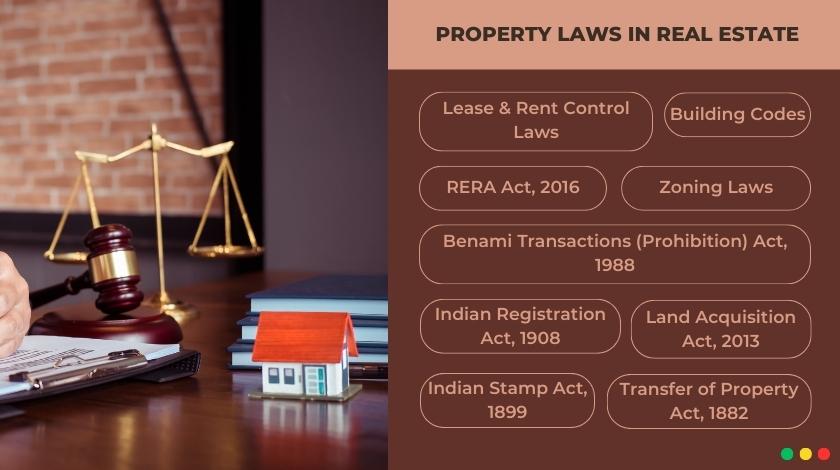
26. The Lease and Rent Control Laws
Lease and Rent Control Laws aim to protect the rights of tenants and landlords by regulating the rules of letting out a property for rent, evictions, and rent increments as specified in the rental agreements. Each state has its own rent control laws which are based on the Rent Control Act, 1948 which was passed by the Govt of India.
27. Building Codes
Regulations that set standards for construction, design, and safety of buildings. They ensure that buildings are safe for occupancy and meet certain quality benchmarks.
28. Zoning Laws
Local municipal authorities and councils regulate the development and use of real estate in a particular area with the help of Zoning Laws. Zoning laws limit industrial or commercial zones ensuring manufacturing and other types of businesses are at a safe distance from residential localities.
29. The Real Estate (Regulation and Development) Act, 2016 (RERA)
The RERA Act was introduced in 2016 to promote transparency, accountability, and efficiency in the real estate sector. It protects the interests of homebuyers and also promotes real estate investment.
30. The Benami Transactions (Prohibition) Act, 1988
The term “Benami” translates to “no name” which means a Benami property is purchased in a different name other than the actual buyer. This Benami Transactions (Prohibitions) Act prohibits buying property in the name of someone other than the buyer, with the intent to hide the real owner’s identity, often for fraudulent purposes.
31. The Indian Registration Act, 1908
The Indian Registration Act mandates the registration of certain documents, including those related to property transactions, to ensure the conservation of evidence, public documents, and prevent fraud.
32. Transfer of Property Act, 1882
This act details the rules and regulations regarding the transfer of property in India. Transfer of Property Act defines how a rightful owner can transfer his movable and immovable property to another.
33. Land Acquisition Act, 2013
The “Right to Fair Compensation and Transparency in Land Acquisition, Rehabilitation, and Resettlement Act, 2013” is a law that regulates the process of land acquisition by the Government for infrastructural development while ensuring that the landowners receive adequate compensation.
34. The Indian Stamp Act, 1899
This act deals with the payment of stamp duty in the country, which is essential for the legal validation of any property-related document. The primary objective of this Indian Stamp Act was to general money for the Government
B. Types of Real Estate Properties & Size
B1. Residential Property
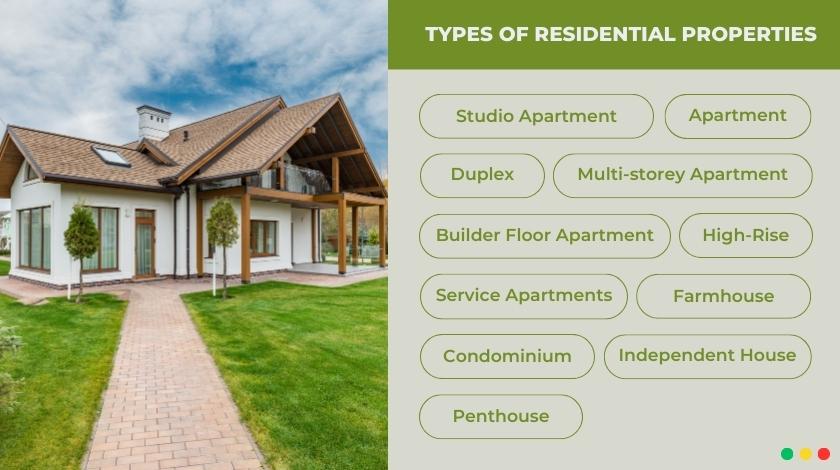
35. Apartment
An apartment, also known as “flat” in India, is a self-contained housing unit, typically occupying a part of the building, generally on a single storey. The building containing several individual apartments is called an ‘apartment building/complex’.
36. Studio Apartment
A compact living unit where the bedroom, living room, and kitchenette are combined into a single open space. It is considered residential property when used as a primary dwelling space for an individual or a couple.
37. Multi-storey Apartment
A tall building with multiple floors, each housing individual or multiple residential units. It's classified as residential when units are primarily for living purposes.
38. Builder Floor Apartment
A single, independent floor in a building, usually without the amenities of a multi-storey apartment complex. It's considered residential when it's inhabited by families or individuals as their main residence.
39. Service Apartments
Apartments equipped with hotel-like amenities, such as housekeeping. While they can be used for short-term stays, they're considered residential when used for longer-term accommodation, blending the comforts of a home with the services of a hotel.
40. Condominium
A condominium, or condo, is a single unit within a larger building or complex. Owners have sole ownership over their unit and share ownership of common areas with other unit owners.
41. Duplex/Twin House
A duplex is a single building that contains two separate housing units, either next to each other or one above the other, each with its separate entrance.
42. Farmhouse
A farmhouse is a property in an agricultural land, used for residential purposes. It is usually surrounded by a farm or landscaped garden that’s spread over an enormous land area.
43. High-Rise
The term typically describes buildings having 7 or 8 storeys or more. In a Central Business District, this could mean buildings having 25 storeys or more from the ground level.
44. Independent House or Single-Family Home
This refers to a standalone house that is meant for the occupancy of a single family. It doesn’t share walls with any other residence and usually comes with its own plot of land.
45. Penthouse
A luxurious apartment unit located on the topmost floor of a building, often offering panoramic views and exclusive amenities. However, the definition of a penthouse is changing in current times, and now refers to a living unit that has a different layout from the other living units in the building, offering ample outdoor space and good views, but not necessarily on the top floor.
B2. Commercial Property
46. Central Business District (CBD)
Any commercial area, located in the centre of a city, and the radius of 2-3 kms surrounding it, is called a Central Business District (CBD). This is the hub of all major commercial activity in the city, comprising financial institutions, large corporate entities and retail stores.
47. Commercial Plots
and specifically zoned or earmarked for business purposes. They're intended for the construction of commercial buildings or structures.
48. Office Buildings
Structures specifically designed to house businesses and corporate operations. They become commercial properties when leased out to businesses to generate rental income.
49. Office or Work Spaces
Individual rooms or areas within an office building, meant for businesses. These spaces are commercial when they're rented or owned by companies for business operations.
50. Retail Spaces
Retail real estate are properties that are designed to sell goods to the public. Examples include malls, shopping centers, and standalone shops. They're considered commercial when they're used primarily for business purposes and generate income.
51. Warehouses
Large buildings meant for storing goods. These can be used by manufacturers, wholesalers, or logistics companies. They're classified as commercial if they're used for business storage or distribution purposes.
52. Industrial Property
Areas used for the production, manufacturing, or distribution of goods. Examples include factories and processing plants.
53. Mixed-Use Buildings
Properties that combine both residential and commercial units. For instance, a building might have shops on the ground floor and apartments above.
54. Business Parks
Clustered areas of office buildings or industrial spaces, designed to cater to specific industries or businesses.
55. Hospitality Property
Commercial properties used in the hospitality industry, like hotels, motels, and resorts.
56. Storage Units
Spaces rented out to individuals or businesses to store goods. Though smaller than warehouses, they are commercial when used for business storage.
57. Service Centers
Properties meant for providing services, such as car service stations, salons, or dry cleaners.
B3. Size of the Property
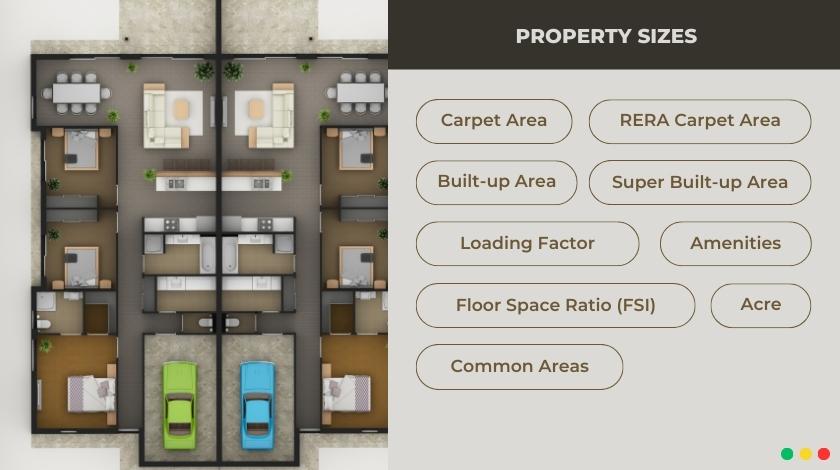
58. Acre
Acre is a term commonly used for large pieces of land in India , equivalent to about 43,560 square feet or 4046.87 square metres.
59. Carpet Area
Carpet Area refers to the actual usable area within the walls of the apartment or house where you can actually lay out a carpet. [Carpet Area = Area of all the rooms - Thickness of internal walls]
59a. RERA Carpet Area
RERA defines carpet area as the space taken up by the actual usable area within the house as well as the area of internal walls (excluding the area of external walls of the house). [RERA Carpet Area = (Carpet Area + Thickness of internal walls) - Thickness of outer walls]
60. Built-up Area
Built-up Area refers to the area encompassing the Carpet Area, area of additional spaces in the house like balconies, open terraces, etc., as well as the thickness of external walls. [Built-up Area = Carpet Area + Area of extra usable spaces + Thickness of internal walls]
61. Super Built-up Area
Super Built-up Area is the total area of Built-up Area as well as the proportionate area of the amenities or common areas in the building or society that can be used by the house/apartment owner. These common areas include staircases, lift, lobby, clubhouse, swimming pool, etc.
61a. Loading Factor
Loading Factor is the percentage of common areas relative to the actual living space. An ideal loading factor would be 60%; if the loading factor exceeds this threshold it means that the Super Built-up Area is way larger than the Carpet Area. Note that the actual or minimum acceptable loading factor can differ from city to city. [Loading Factor = (Super Built-up area / Carpet Area) - 1]
62. Floor Space Ratio (FSI)
FSI, also known as Floor Area Ratio (FAR), refers to the actual (maximum) permitted area of the land that can be used for construction. [FSI or FAR = Built-up Area ÷ Area of the Land]
63. Amenities
Amenities are the features of a property that enhance the desirability of the property to potential buyers, making it more valuable to them. Some examples of amenities are clubhouse, swimming pool, indoor games room, meditation lawn, yoga room, etc.
64. Common Areas
The common areas of a property, like parking lot, corridors, elevators, lobby, staircase, etc., is not owned by any particular individual and is available for use by all the residents of a particular property. All residents have to collectively ensure the maintenance and upkeep of common areas.
C. Real Estate Process Terms
C1. Real Estate Terms Related to Buying and Selling
67c. Exclusive Right-to-Sell Listing
68. Multiple Listing Service (MLS)
69. Ready to Move vs Under Construction

65. Real Estate Agent
Real estate agent, often referred to as a real estate broker, is a licensed professional who represents buyers or sellers in real estate transactions.
66. Listing
Listing is a public announcement showcasing a property that’s available for sale or rent.
67. Listing Agreement
A written contract where the property owner grants rights to a broker to represent the seller and find a buyer to whom they can sell or lease the property. There are generally three types of listing agreements.
67a. Open Listing
A property listing agreement where the owner may hire multiple brokers. The broker who successfully finds a buyer earns the commission. If the owner sells the property themselves, no commission is owed to any broker.
67b. Exclusive Agency Listing
An agreement where one broker is authorised to act as the exclusive agent of the property owner, but the owner retains the right to sell the property directly without paying a commission.
67c. Exclusive Right-to-Sell Listing
A contract granting one broker the sole rights to represent and sell a property. Regardless of who finds the buyer, the broker earns the commission. This is the most common type of listing agreement.
68. Multiple Listing Service (MLS)
A collaborative database where brokers list properties for sale. The MLS helps ensure broad exposure of properties for sale in their localities and facilitates selling by boosting the ability to find a buyer by sharing information among brokers.
69. Ready to Move vs Under Construction
'Ready to Move' properties are completed, and buyers can move in immediately. 'Under Construction' properties are in the process of being built and are not yet complete.
70. Comparative Market Analysis (CMA)
A comparative market analysis assists in determining an appropriate value of a property by evaluating similar properties that were recently sold in the area.
71. Home Inspection
Home inspection is a professional assessment of a property's structural and functional condition, to identify potential issues, often carried out before finalising the property purchase.
72. Asking Price
Asking price is the initial price set by the seller for the property. It's the starting point for price negotiations between buyers and sellers.
73. Offer
A formal proposal by a potential buyer detailing the terms and price at which they're willing to purchase a property.
74. Counter-offer
A reply to an initial offer, suggesting modifications, usually related to price, closing date, or contingencies.
75. Closing
The final step in property sales when ownership legally transfers from seller to buyer after all conditions are met and documents are signed.
76. Closing Costs
Additional charges incurred during a property sale, such as taxes, attorney fees, and loan processing costs, paid at the closing of the transaction.
77. Escrow
An account held by a neutral third party (often a lawyer or title company) during a transaction. Funds or a deed are held in escrow until all contractual obligations are met, at which point they are released to the appropriate party.
78. Bayana (Token Amount)
Bayana is a partial payment made by a buyer to the seller to secure the property and initiate or freeze the sale, signifying serious intent to purchase. The term “Bayana” is generally used in Delhi, Punjab, Haryana, Rajasthan, Jharkhand, Uttar Pradesh, and Bihar,
79. Possession Certificate
A document issued by the local municipal authority that confirms a builder's completion of a project as per approved plans, allowing the buyer to take possession.
80. Property Verification
The process of verifying a property's legal status by checking its title, ensuring there are no disputes, and confirming ownership.
81. Due Diligence
A thorough investigation into a property's details and legalities before purchasing, ensuring the buyer is getting what they're paying for.
C2. Real Estate Terms Related to Renting and Leasing Terms
82. Lessor
Lessor is the person (landlord) who leases out a property to a tenant or buyer (‘lessee’) of the property under a ‘Lease agreement’. Lessors define the rights and obligations of both parties in the lease agreement, and spell out the ways in which the tenant/lessee can or cannot use the property, including special privileges like early termination, renewal of the lease, etc.
83. Lessee
Lessee is the person (tenant or buyer) who holds the lease of a property and has the right to use it for the duration of lease as specified by the lessor/landlord.
84. Lease
A legal contract that allows someone to use an asset (lessee), such as a property, for a specific period, often in exchange for regular payments (rent). At the end of the lease term, the asset is returned to its owner (lessor).
85. Lease/Rent Agreement
Lease/rent agreement written contract between a property owner and a tenant that outlines the terms under which the tenant can use and occupy the property, usually in exchange for rent.
86. Leave and Licence Agreement
This allows a person to use a property for a period without transferring full rights over it, i..e, the leave and licence agreement grants only the permission to occupy the property. This is typically more flexible for home owners and can be terminated more easily than a lease.
87. Lease Term
The duration for which the lease agreement is valid, such as six months, one year, etc.
88. Lease Break
Ending a lease agreement before its specified term, which might result in penalties or charges for the tenant.
89. Month-to-Month Lease
A lease agreement that is renewed automatically every month until either the landlord or the tenant decides to terminate it.
90. Lease Renewal Option
A clause in a lease that allows the tenant the right to extend the lease term, often under predetermined conditions.
91. Notice Period
The amount of time (often 30 days) that a landlord or tenant must provide before making changes to or ending a lease agreement.
92. Rent
Regular payments made by a tenant to a landlord in exchange for living in or using their property.
93. Fair Market Rent
An estimate of the amount a property should rent for, based on current market conditions and comparable properties.
94. Security Deposit
A sum given by the tenant to the landlord as a safeguard for damages or unpaid rent, usually returned at the end of the lease, minus any deductions.
95. Maintenance Charges
Regular fees, separate from rent, that tenants might pay to cover upkeep of common areas and amenities in a property complex.
96. Rent Agreement Renewal
The act of extending the rent agreement after its initial term (typically 11 months), potentially with new terms or rent amounts.
97. Tenant Verification
A process where the landlord checks a potential tenant's background, financial stability, and rental history.
98. Vacate Notice
A formal communication in writing made from either landlord or tenant signalling the intent to end the lease and indicating the date by which the property should/will be emptied.
99. Eviction
The legal process of removing a tenant from a rental property, usually due to violation of lease terms or non-payment of rent.
100. Sublease (or Subletting)
An arrangement where the original tenant rents out the property (or a portion of it) to another party. The primary lease with the landlord remains in the name of the original tenant.
101. Rental Yield
A percentage that shows the annual return from renting out a property in comparison to its market value.
102. Rent Control
Rent control is regulated by the Government regulations that limit the amount landlords can charge for rent and protect tenants from sudden or unreasonable rent increases.
D. Financial Terms in Real Estate
D1. Property Taxes & Fees
103. Property Tax
Property tax is a recurring tax paid by property owners to the local government or municipality. The amount is usually based on the value of the property and location. It funds public services like roads and schools. Payment is typically required annually.
104. House Tax
House Tax is a type of property tax specific to residential buildings. This tax is levied by the local municipal bodies and is based on the value, size, and location of the house. The funds collected through this tax are used for the maintenance and development of local infrastructure and services within the municipality. Regular payment is often required, and the exact frequency (annually, bi-annually, etc.) can vary based on local regulations.
105. Stamp Duty
Stamp duty is a tax paid to the government on the legal documentation of property transactions (when you buy or transfer property). It is generally a percentage of the property's value. The exact rate varies by location and the property's purpose (residential, commercial, etc.). It ensures the transfer is legally recorded.
106. Property Registration Charges
Registration Charges are the fees paid to the local government to officially register a property under the buyer's name, giving legal ownership to the buyer. The registration charges are determined by the market value of the property, often ranging from 1% to 3%, and can vary from city to city.
107. Land Conversion Fee
Land conversion fees must be paid to the authorities to change the use of a piece of land (either from agriculture to residential or from residential to commercial use). The exact charges depend on the nature, location, and area of the property, and it can differ from state to state. For example, in Karnataka, a fixed amount of ₹327, ₹218, or ₹89 will be charged depending on the location of the land (i.e., 12km within City Corporation Limits, Taluk Centre, or rural areas respectively); 3% of the land value if charged in Andhra Pradesh, 10% of the land value in Bihar, ₹60 per sq yard to ₹200 per sq yard in Rajasthan, etc.
108. Goods and Services Tax (GST) in Real Estate
A value-added tax in India on the sale of goods and services. For real estate, it applies to under-construction properties but not on completed or resale properties. Rates can vary based on the type of property.
109. TDS on Property Sale
1% of the property value is deducted as TDS (Tax Deducted at Source) on sale of a property, if the property value is greater than ₹50 Lakh. Under Section 194-IA of the Income Tax Act, the buyer is responsible for deducting this tax from the amount payable to the seller and pays it to the government. This is a way to ensure tax collection at the source of the transaction.
110. Capital Gains Tax
Capital gains tax is a tax that needs to be made on the profit received from selling a property (as it is considered an income). The tax paid on capital gains can be long-term or short-term, and the tax levied can range from 10-15%. If held longer, it may qualify for tax benefits.
111. Appraisal Fee
Appraisal Fee is a one-time fee paid to a professional who assesses the value of a property. This appraisal helps lenders decide how much a home is worth and how much they are eligible or willing to loan.
112. Annuity
When selling a property or home through life annuity, the owner receives the purchase price of a property in monthly instalments (pension), typically for the rest of their life.
113. Maintenance Fee
A periodic charge that homeowners must pay, especially in multi-unit complexes, for the upkeep of common areas, security, etc. the builder is typically responsible for paying the maintenance fees until the buyer takes possession of the property.
114. Brokerage Fees
When a real estate broker (or agent) helps a seller and buyer get in touch with each other and they decide to complete the real estate transaction, a percentage of the transaction or property value is paid to the broker or brokerage firm by both parties. Brokerage fees generally depend on the price of the property and can range from 0.5% to 2% in major tier-1 cities and can go up to 6% in tier-2 and tier-3 cities.
D2. Home Loans & Mortgage
115a. Adjustable-Rate Mortgage (ARM)
119d. Hybrid Loans or Combination Interest Rates
122. Equated Monthly Instalment (EMI)
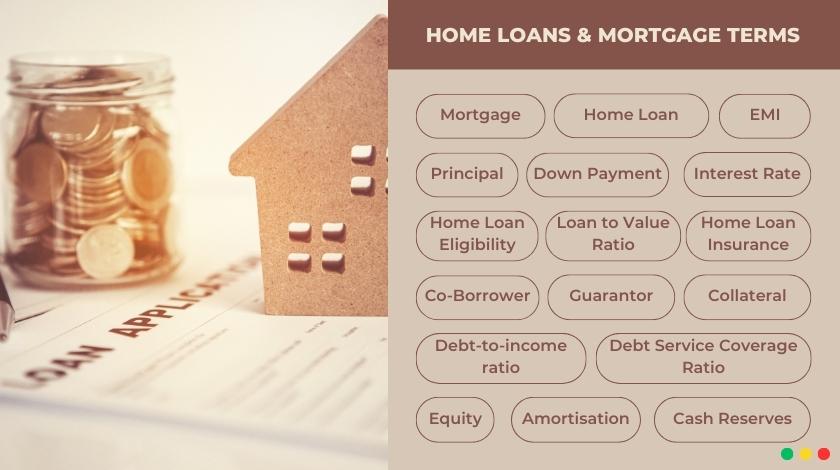
115. Mortgage
A legal agreement where a bank or other lender loans money at interest in exchange for taking the title of the debtor's property, with the condition that the conveyance becomes void upon the payment of the debt.
115a. Adjustable-Rate Mortgage (ARM)
A type of mortgage where the interest rate can change periodically based on an underlying benchmark interest rate or index. Initial rates are often lower, but there's a risk they can increase in the future.
115b. Fixed-Rate Mortgage
A mortgage where the interest rate remains constant throughout the entire duration of the loan. This provides predictable and stable monthly payments.
115c. Capped Rate
The maximum interest rate that can be charged on a variable or adjustable-rate mortgage.
116. Home Loan
Home loan is the money borrowed from a financial institution to buy, construct, or renovate/repair a house or residential property. The lender will consider the home or property as collateral for the loan.
117. Principal Amount
Principal amount is the original sum of money borrowed in a loan or invested, excluding interest.
118. Down Payment
An initial payment made when buying something on credit, typically a percentage of the total purchase price.
119. Interest Rate
The percentage of a loan amount you'll pay in interest over a year. Interest rates can significantly affect or influence the buyer’s ability to afford a home.
119a. Base Rate
The minimum threshold interest rate set by RBI from 1st July 2010, below which the banks are not usually permitted to lend home loans to borrowers. The base rate includes all the elements of the lending rate, upon which banks add other customer specific charges as considered appropriate to determine their actual lending rates.
119b. Floating Interest Rate
Floating interest rate, also known as variable interest rates, fluctuates periodically over time based on market conditions and the base rate. If the base rate increases, the floating interest rate will also increase. When the floating rate drops, borrowers save money with lower EMI payments.
119c. Fixed Interest Rate
Fixed Interest Rate is a type of interest rate that remains constant for a set period or for the entire term of the loan.
119d. Hybrid Loans or Combination Interest Rates
With a hybrid loan, borrowers can get a combination of fixed and floating interest rates during the loan tenure. They will receive a fixed interest rate for an initial period of time, and after expiry of this time period, the interest rate becomes floating, adjusting periodically for the rest of the loan tenure.
120. Home Loan Eligibility
Criteria set by lenders that a borrower must meet to qualify for a home loan.
121. Home Loan Insurance
Home Loan Insurance covers the borrower and ensures repayment of the outstanding home loan amount in the event of the borrower's demise, ensuring that the family isn't burdened with loan repayment.
122. Equated Monthly Instalment (EMI)
EMI is the fixed monthly payment made towards repaying a loan.
123. Pre-EMI
Pre-EMI is the monthly payment towards the interest of the loan amount drawn (you will not be repaying anything towards the principal amount). You will get the option to pay Pre-EMIs for loans where the property is still under construction.
124. Co-Borrower
A Co-Borrower applies for a loan along with the primary borrower and is equally responsible for a loan or mortgage and its repayments.
125. Guarantor
Guarantor is a person who guarantees to pay back a loan in case the primary borrower defaults or is unable to make repayments.
126. Collateral
Collateral is an asset offered as security for repayment of a loan. In case of non-payments towards the loan, the lender has the option to take control, repossess, or claim ownership of the collateral.
127. Refinancing
Refinancing is a way of replacing an existing loan with a new one, usually with better terms or a lower interest rate. You can refinance a loan, mortgage, or investment.
128. Loan to Value Ratio (LTV)
Loan to Value Ratio (LTV) is the ratio of the loan amount to the appraised or market value of the property or collateral against which the loan is being borrowed. [LTV = Loan Amount ÷ Value of the property]
129. Loan Processing Fee
Loan processing fee is a one-time charge added by the lenders for processing a loan application, which involves some administration costs ranging from 0.5% to 2.5% of the total loan amount.
130. Equity
Equity is the difference between the market value of a property and the amount owed on the mortgage. To calculate your home equity, get an estimate of the current value of your home and subtract the loans you have secured against your house.
131. As-is where-is basis
As-is where-is basis means that you are buying a property in its existing condition, inheriting all the good and bad, physical and legal conditions of the property, with or without encumbrances.
130. Amortisation
Amortisation is the gradual reduction of a loan debt by making regular payments of both principal and interest over a specified duration of time. You can easily create an amortisation schedule or a comprehensive table detailing the basic loan information i.e., loan tenure, number of periodic payments to be made, rate of interest, principal amount, and balance principal.
133. Bridge Loan
Bridge Loan is a short-term loan that provides immediate cash flow for individuals who need immediate funds to purchase a property until a more permanent financing solution can be arranged or while they wait for their home to be sold.
134. Debt-to-income ratio
A ratio used by lenders that compares an individual's monthly debt payment to their overall income [DTI = monthly EMI ÷ gross monthly income]. A good DTI ratio is 36% or lower, up to a maximum of 43%.
135. CIBIL
Credit Information Bureau (India) Limited, an Indian credit information company that maintains records of individuals' loan and credit card bills to determine creditworthiness.
136. Credit History
Credit history is a record of a person's borrowing and repaying habits towards credit cards or other loans, and a record of any unpaid, outstanding loans.
137. Cash Reserves
Cash reserves, or emergency funds, refers to any liquid funds or assets that a borrower has access to, after paying the downpayment and closing costs. This is often considered by lenders during the loan approval process.
138. Foreclosure
Foreclosure is the legal process where the ownership of a property shifts to the lender or bank due to the homeowner's (or borrower's) failure to meet the loan repayment terms.
139. Pre-Approval Letter
Pre-approval letter is a letter from a lender indicating that a borrower qualifies for a certain loan amount based on their financial history, and that the lender is (tentatively) willing to lend the money as loan. However, this does NOT mean a guaranteed loan offer; the lender will thoroughly look into the borrower’s credit history, income, and expenses to make a final decision.
140. Debt Service
The total amount of money required to make the loan repayments (both interest and principal) on an outstanding debt over a period of time.
141. Debt Service Coverage Ratio (DSCR)
The DSCR is calculated by dividing the annual net operating income (NOI) of the property by the debt service (annual debt payments including principal and interest). For example, a DSCR of 1.5 means the NOI must be 1.5 times (or 150%) the amount of the annual loan payments.
D3. Value of the Property
142. Fair Market Value (FMV)
Fair market value is the reasonable selling price of the property in an open and competitive market, where the seller and buyer have a good amount of knowledge about it. This is the price that a buyer would likely pay for the property and the seller would make the trade without any pressure.
143. Appreciation
The increase in the value of a property over a period of time depending on various factors like market demand and supply, location improvements, area development, or interest rates. Currently the average annual property appreciation rate in India in 6%, which differs significantly from city to city.
144. Depreciation
The annual decrease in the value of a property over time because of wear and tear, age, or adverse changes in the neighbourhood or local economy. According to the Income Tax Act, depreciation rate for residentials buildings is set at 5% whereas commercial buildings are applicable for a depreciation of 10%.
145. Real Estate Appraisal
Real Estate Appraisal, also known as property valuation, is the process of estimating the true market value or price of a property, often conducted by a professional certified appraiser in an unbiased manner.
146. Assessed Value
The valuation placed on a property by a public tax assessor based on which the appropriate taxes are levied on it. It is usually an estimated value of the property after considering the overall condition of the property, location, square footage, amenities or features, etc., in comparison to similar properties.
147. Capitalization Rate (Cap Rate)
Capitalization rate (Cap rate) is a real estate valuation standard that compares different real estate investments and roughly determines the potential return on an investment. [Cap Rate = Net Operating Income ÷ Current Market Value]
148. Capital Gain
Capital Gain is the profit made from selling an asset (like real estate property) for more than what you originally paid.
149. Capital Loss
Capital Loss is the loss incurred when an asset (like real estate property) is sold for less than its purchase price.
150. Economic Obsolescence
Economic Obsolescence is the decrease in property value due to external factors like changes in the economy, increase crime rates in the area, or new zoning regulations, etc.
151. Liquidity
Real Estate Liquidity is used to describe how quickly an asset, like real estate, can be converted into cash or sold without affecting its market price.
152. Net Operating Income (NOI)
Net Operating Income (NOI) is used to calculate the profitability of a particular investment, excluding mortgage payments. [NOI = Revenue generated by the property – Operating Expenses]
153. Replacement Cost
Replacement Cost is the cost to be paid to replace an existing property or asset with a similar asset of similar quality and functionality, at the current market price.
154. Title Insurance
Title Insurance is an insurance policy that protects home buyers against any loss caused due to defects in the title to a property.
In the dynamic realm of real estate, understanding the terminology is not just about mastering the real estate words & jardon; it's about making informed decisions, ensuring transparent transactions, and safeguarding one's investments. Whether you're a property enthusiast, a seasoned investor, or someone taking their first steps in the property market, having a clear grasp of real estate terms can drastically enhance your confidence and clarity.
Our carefully put together dictionary of real estate terminologies is not a one-time thing. Since the real estate business is always changing, we are working to keep this glossary up-to-date. This makes sure that all the words related to real estate will be readily available for easy viewing and easy access, reliable, up-to-date, and a long-term resource for all your real estate needs in India.
We hope this guide to real estate terms serves as your go-to manual to understand any real estate vocabulary, empowering you to navigate the details and intricacies of real estate with ease and assurance.
